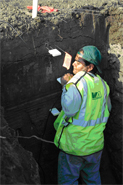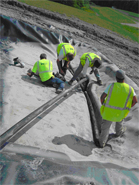Principal Investigator: Dr. Milind V. Khire, P.E.
Research Assistant: Ramil Mijares
Funding Agency: Environmental Research & Education Foundation and Waste Management
Abstract
This project is about hydraulic equivalency of prescribed RCRA caps versus earthen (evapotranspirative) final caps for sub-humid climates such as Michigan. The hydraulic equivalency will consider the effect of the waste layer and gas pressures that exist in actual final caps. Majority of previous research on this topic has been based on lysimeter designs that do not consider these effects. However, regulators only allow relatively low demonstrated percolation (~few mm/year) through the alternative cap before a permit is issued. Earthen caps have many advantages compared to conventional composite liner caps. These advantages include: cost savings; ability to grow deep rooted plants or trees on landfill cap for phytoremediation, long-term erosion control, fiber revenues, aesthetics; and more.
In this project, field-scale evapotranspirative caps were constructed at a landfill located near Detroit, Michigan. Two tests sections, 50 ft by 100 ft each, were built on the top of waste that has reached final elevations. Both test sections are made up of native soil (silty clay glacial till). The north test section is 4.5 ft thick and the south test section is 6 ft thick. In order to directly quantify the net percolation through the caps, a 20 ft x 20 ft x 2 ft deep vented (or pressure controlled) enclosure lysimeters were constructed within the middle of each of the test sections. Rest of the test section is on an existing waste that was placed in the cell in 1990s.
Field water balance data has been monitored by installing over 75 total sensors for the measurement of volumetric water contents, soil matric suctions, temperatures, and gas pressures. Nests of sensors were installed up-gradient and down-gradient of both test sections, as well as within the upper portions of the underlying waste. A pressure transducer was placed at the bottom of the lysimeters to quantify the percolation through he caps. This lysimeter design is significantly cheaper compared the EPA ACAP lysimeters. Climatic data has been collected using a meteorological station installed at the site.
Resulting Publication
- Khire, M., and Mijares, R. (2008), “Influence of the Waste Layer on Percolation Estimates for Earthen Caps Located in a Sub-humid Climate” ASCE Geotechnical Special Publication No. 177: Geotechnics of Waste Management and Remediation, American Society of Civil Engineers, Reston, VA, Editors: Khire et al., pp. 88-95.




